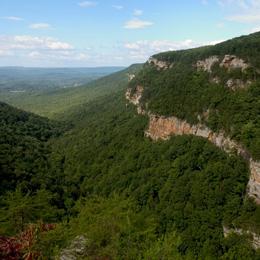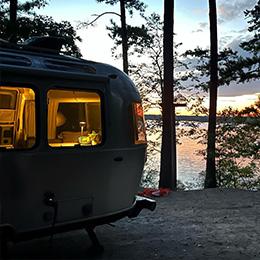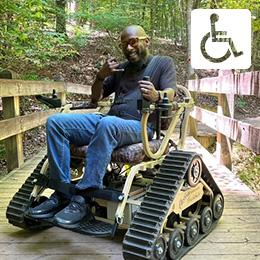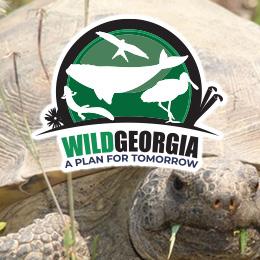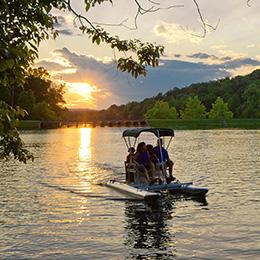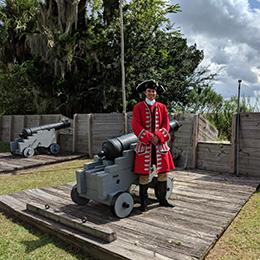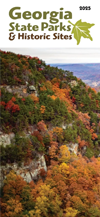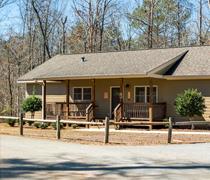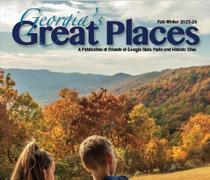Blackbeard Island NWR
Blackbeard Island NWR offers two, three-day archery deer hunts each year. These hunts are the oldest managed archery hunts of any within the entire National Wildlife Refuge System. Hunters may take up to five deer, no more than two antlered, as well as an unlimited number of feral hogs. The refuge is accessible only by boat, and hunters must make their own transportation arrangements. Boaters should pay close attention to tide tables.
Bond Swamp NWR
Established in 1989 to conserve forested wetland habitat, Bond Swamp National Wildlife Refuge is within the floodplain of the Ocmulgee River. Opportunities to hunt deer, turkey and feral hogs attract hunters from across the state. Small game hunting for squirrel, rabbit and quail also is available. Access to the 7,760-acre refuge is primarily by foot with limited road access.
Chattahoochee-Oconee National Forest (outside of WMAs)
The Chattahoochee-Oconee National Forests encompass over 867,000 acres across northern and central Georgia, offering diverse hunting opportunities in varied terrains—from the Appalachian foothills to the Piedmont woodlands. Hunters can pursue white-tailed deer, black bear, wild turkey, and small game species throughout the forests. Coyotes may be hunted during open seasons with weapons restrictions for game species in season; no night hunting; electronic calls may be used.
Prohibited:
- Transportation of any loaded weapon in a motor vehicle
- Possession of alcohol when hunting
- Placing, leaving, or depositing any food, bait, or garbage in a manner likely to attract or concentrate any wildlife, whether for purposes of hunting or viewing animals. Failure to properly store food or garbage so as to prevent access by wildlife
- Baiting is prohibited
- No night hunting
Cumberland Island NS
Cumberland Island National Seashore, Georgia’s largest and southernmost barrier island, offers unique hunting opportunities within its protected wilderness. The National Park Service conducts six managed hunts annually, targeting white-tailed deer and feral hogs to help maintain ecological balance. Hunts include archery, primitive weapons, modern firearms, and a special adult/child hunt.
Eufaula NWR
Eufaula National Wildlife Refuge (11,184 acres) offers hunting on its Georgia side, primarily in the Bradley Unit. Opportunities include quota waterfowl hunts from designated blinds, archery and youth firearm deer hunts, and feral hog hunting during deer seasons. Special youth hunts are also available. Access requires a refuge permit and compliance with federal and state regulations.
Fort Eisenhower
Fort Eisenhower in Augusta, GA, offers diverse hunting on about 50,000 acres of military training lands. Hunting is available by permit through a lottery system and requires a Georgia hunting license plus a Fort Eisenhower permit. Allowed species include white-tailed deer, wild turkey, small game, feral hogs, and waterfowl. Hunters must follow all base regulations, complete check-in/out procedures, and be aware that access may be limited during military training.
Fort Stewart & Hunter Army Airfield
Fort-Stewart-Hunter Army Airfield is a popular destination for hunters. Each year, over 2,700 individuals will register 37,000+ check-ins to pursue a multitude of game species within the installation boundaries. Fort Stewart-Hunter Army Airfield provides many opportunities to hunt native big game, small game, and waterfowl species. The installation also offers year-round hunting for nuisance feral hogs..
Harris Neck NWR
Harris Neck National Wildlife Refuge in McIntosh County, GA, offers diverse habitats along the Atlantic Flyway and supports migratory birds. Annual managed hunts include a three-day archery season in October and a one-day shotgun season in November. Hunters may harvest deer (limit 5, max 2 antlered), feral hogs, coyotes, and armadillos.
Hartwell Lake
Hartwell Lake in Georgia offers archery-only hunting for deer and turkey in designated areas like Hartwell Dam Quarry, New Prospect Park, and Jenkins Ferry Park. Small game hunting is allowed outside deer and turkey seasons, using shotguns with #4 shot or smaller. Access is walk-in or boat-in only; motorized vehicles are prohibited in gated areas. Portable stands and blinds are permitted but must be removed after the season. A free permit is required for Hartwell Dam Quarry and is available at the Hartwell Lake Visitors Center. All hunting follows Georgia DNR regulations.
Lake Seminole
The Apalachee Wildlife Management Area in Florida and various tracts in Georgia are managed by the respective states as game management areas. Hunting is allowed on all Corps-managed lands and waters if they are not expressly closed.
Lake Sidney Lanier
Lake Sidney Lanier, a U.S. Army Corps of Engineers reservoir in northern Georgia, offers unique hunting opportunities on select islands and peninsulas. The annual Islands Hunt is an archery-only, quota-based event held across 1,100 acres divided into nine zones. Additionally, the Buford Dam Hunt offers an archery-only opportunity on 611 acres around the Lake Lanier Project Management Office and Buford Dam.
Okefenokee NWR
Okefenokee National Wildlife Refuge was established in 1937 and is one of the best-protected wilderness areas in the southeastern United States. Hunters can experience this special place, with three hunting units in the upland portion of the refuge. Hunting is permitted on approximately 3,822 acres during specific times of the year.
Piedmont NWR
Piedmont National Wildlife Refuge, located 25 miles north of Macon, Georgia, was established in 1939 with the purpose of providing a refuge and breeding ground for migratory birds and other native wildlife. Today the refuge consists of 34,000 acres of managed upland pine and pine-hardwood forest. Over 200 species of birds occur on the refuge including the endangered red-cockaded woodpecker. Piedmont NWR provides opportunities for hunting, fishing, wildlife observation, hiking, and enjoying the great outdoors!
Hitchiti Experimental Forest
The 5000 acre Hitchiti Experimental Forest is located about 65 miles southwest of Athens, GA and is the site of the Brender Demonstration Forest, a cooperative effort by the Southern Research Station and the Georgia Forestry Commission to showcase pine management for nonindustrial private landowners.
Richard B. Russell Lake
Public lands surrounding Richard B. Russell Lake provide excellent deer, turkey and small game hunting opportunities. Food plots are planted in various areas to improve habitat and hunting opportunities. In general, there is a rim of public land around the lake that extends at least 300 feet from the shoreline that is open for hunting. The Corps boundary line is marked with orange/redwood colored paint.
Savannah NWR
The Savannah River supports the rich wildlife of Savannah National Wildlife Refuge. Visitors can enjoy the 4.5-mile Laurel Hill Wildlife Drive and trails daily from sunrise to sunset. Hunting is allowed in designated units for deer, turkey, small game, waterfowl, dove, and alligator (with permits). Seasonal hog and coyote hunts help control invasive species. Regulations vary by state and species.
Wassaw Island NWR
Wassaw National Wildlife Refuge, a pristine 10,053-acre barrier island off Georgia's coast, offers a unique hunting experience within its diverse habitats of maritime forests, salt marshes, and undeveloped beaches. Annually, a three-day, non-quota firearm hunt is held in December, permitting hunters to harvest up to five deer (no more than two antlered) and unlimited feral hogs. Access to the refuge is exclusively by boat, requiring hunters to arrange their own transportation and consult tide tables for safe navigation.





